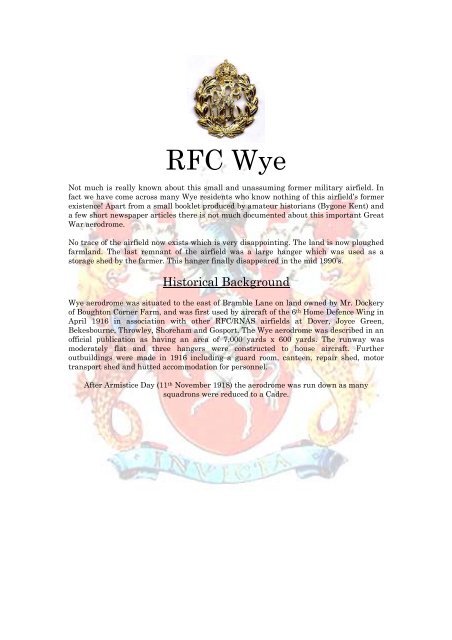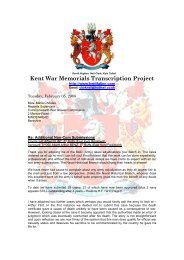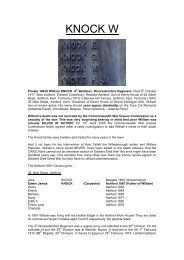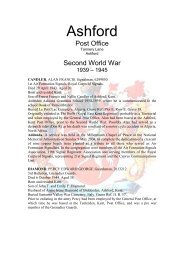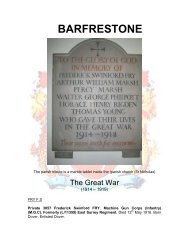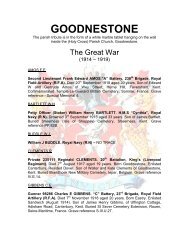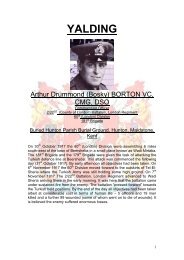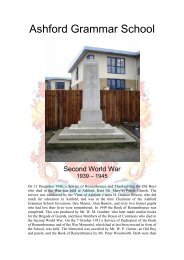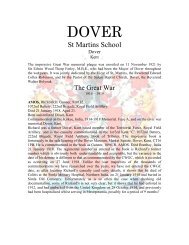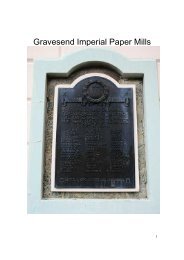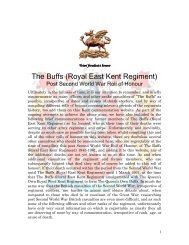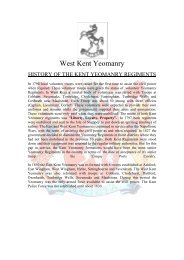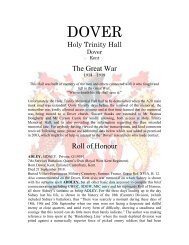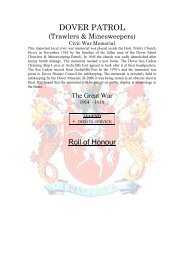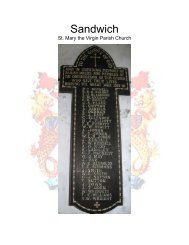You also want an ePaper? Increase the reach of your titles
YUMPU automatically turns print PDFs into web optimized ePapers that Google loves.
RFC <strong>Wye</strong><br />
Not much is really known about this small and unassuming former military airfield. In<br />
fact we have come across many <strong>Wye</strong> residents who know nothing of this airfield’s former<br />
existence! Apart from a small booklet produced by amateur historians (Bygone <strong>Kent</strong>) and<br />
a few short newspaper articles there is not much documented about this important Great<br />
War aerodrome.<br />
No trace of the airfield now exists which is very disappointing. The land is now ploughed<br />
farmland. The last remnant of the airfield was a large hanger which was used as a<br />
storage shed by the farmer. This hanger finally disappeared in the mid 1990’s.<br />
Historical Background<br />
<strong>Wye</strong> aerodrome was situated to the east of Bramble Lane on land owned by Mr. Dockery<br />
of Boughton Corner Farm, and was first used by aircraft of the 6 th Home Defence Wing in<br />
April 1916 in association with other RFC/RNAS airfields at Dover, Joyce Green,<br />
Bekesbourne, Throwley, Shoreham and Gosport. The <strong>Wye</strong> aerodrome was described in an<br />
official publication as having an area of 7,000 yards x 600 yards. The runway was<br />
moderately flat and three hangers were constructed to house aircraft. Further<br />
outbuildings were made in 1916 including a guard room, canteen, repair shed, motor<br />
transport shed and hutted accommodation for personnel.<br />
After Armistice Day (11 th November 1918) the aerodrome was run down as many<br />
squadrons were reduced to a Cadre.
<strong>Wye</strong> Squadrons<br />
On 1 st February 1916 farmland to the east of Bramble Lane was acquired by the Royal<br />
Flying Corps for use as a stand by landing ground.<br />
On 20 th February 1916 work started to level the ground and construct a runway.<br />
Personal facilities for the men were still very rudimentary. Those on duty lived in tents<br />
on the airfield. Many officers and men were sent to billets in private households<br />
throughout <strong>Wye</strong>.<br />
On 1 st April 1916 the first flying machine (from a home Defence squadron) successfully<br />
landed at <strong>Wye</strong>. Almost immediately it was decided to upgrade the airfield and to use it as<br />
a pilot training school.<br />
On 24 th July 1916 No 20 Reserve Squadron, Royal Flying Corps moved to <strong>Wye</strong> from<br />
Guston near Dover. This squadron operated the following types of flying machines: Avro<br />
504, De Havilland D.H 4, De Havilland D.H 6, Be.2C, Be.12, Re.8. It left <strong>Wye</strong> 1 st June<br />
1917 for Wyton in Cambridgeshire.<br />
In July 1916 No 61 Squadron, Royal Flying Corps was formed at <strong>Wye</strong>. In late August<br />
1916 this squadron was absorbed into No 63 Squadron, Royal Flying Corps and all it’<br />
personnel left <strong>Wye</strong>.<br />
On 7 th December 1916 No 50 Reserve Squadron, Royal Flying Corps arrived at <strong>Wye</strong><br />
leaving a week later 14 th December 1916.<br />
On 8 th January 1917 No 51 Reserve Squadron Royal Flying Corps arrived at <strong>Wye</strong><br />
from Filton near Bristol with a similar assortment of aircraft including Martinsyde<br />
Elephants. They left <strong>Wye</strong> on 14 th May 1917 for Waddington in Cambridgeshire.<br />
On 29 th May 1917 No 65 Squadron Royal Flying Corps arrived at <strong>Wye</strong> with their<br />
Sopwith Camels. They remained at <strong>Wye</strong> until 24 th October 1917 when it moved to La<br />
Lovie in France.<br />
On 2 nd February 1916 No 42 Reserve Squadron, Royal Flying Corps was formed at<br />
Hounslow by personnel from No 19 and No 51 Reserve Squadron’s Royal Flying<br />
Corps. On 31 st May 1917 it moved to <strong>Wye</strong> where it was re-designated No 42 Training<br />
Squadron, Royal Flying Corps. It operated the following types of machines at <strong>Wye</strong>:<br />
A3144 (B.E.2e), A5156 (R.E.7), B2677 (D.H.6), A1461 (F.K.3), B6478 (R.E.8), A2006 (Avro<br />
504a), A9787 (Avro 504j), H8257 (Avro 504k), A7311 (Sopwith Pup), F9637 (Sopwith<br />
Camel), B1934 (Curtiss JN-4a), C5025 (Bristol M1c).<br />
About this time in 1917 the <strong>Wye</strong> aerodrome was extensively used by the American Air<br />
Service. Many American pilots received their flying training alongside their British<br />
counterparts at <strong>Wye</strong> before being drafted to frontline fighter squadrons in France. <strong>Wye</strong><br />
(42 Training Squadron) continued to be used by the Americans until February 1919.
On 18 th May 1917 No 66 Reserve Squadron, Royal Flying Corps was formed at <strong>Wye</strong><br />
flying modern aircraft including Sopwith Pup single seater fighters. On 19 th June 1917 it<br />
moved from <strong>Wye</strong> to Yatesbury.<br />
On 17 th September 1917 No 86 Squadron, Royal Flying Corps arrived at <strong>Wye</strong> from<br />
Shoreham, Sussex. They left <strong>Wye</strong> on 16 th December 1917 for Northolt in Middlesex.<br />
On 1 st April 1918 the Royal Flying Corps (RFC) became the Royal Air Force (RAF) and<br />
all squadron titles changed accordingly.<br />
In February 1919 No 2 Squadron, Royal Air Force arrived at <strong>Wye</strong> as a Cadre without<br />
their Sopwith Camels, moving to Dover in June 1919.<br />
On 15 th February 1919 No 3 Squadron, Royal Air Force arrived at <strong>Wye</strong> as a Cadre. It<br />
left <strong>Wye</strong> 2 nd May 1919 for Dover.<br />
In June 1919 No 42 Training Squadron, Royal Air Force left <strong>Wye</strong> and the <strong>Wye</strong><br />
aerodrome then briefly became No 1 Distribution Centre, Royal Air Force before being<br />
returned to farmland in January 1920.<br />
Flying Accidents at <strong>Wye</strong><br />
During the Great War there were a few flying accidents at <strong>Wye</strong>. We have managed to<br />
identify the following men killed whilst operating from <strong>Wye</strong>. It is quite likely that there<br />
are additional casualties. It is very hard to trace these deaths because the<br />
Commonwealth War Graves Commission do not record how a man died.<br />
It’s a great pity that the people of <strong>Wye</strong> in the 1920’s chose not to include these men’s<br />
names on their church war memorial plaque. All these brave airman resided in <strong>Wye</strong> at<br />
the time of their deaths and most met their deaths at <strong>Wye</strong>…
AGNEW J.P<br />
Lieutenant Joseph Paul AGNEW MC. 42 nd Training Squadron, Royal Flying Corps<br />
(RFC). Formerly 79 th Company, Machine Gun Corps (MGC). Died Flying Accident<br />
Boughton Corner Farm, <strong>Wye</strong>, Ashford, <strong>Kent</strong>. (Sopwith Camel) 14 th August 1918 aged 22<br />
years. Born Cowper, Northumberland. Son of Thomas and Jane Ann Agnew of The Post<br />
Office, Cowpen Village, Blyth, Northumberland. Buried in the Ashford Cemetery. Grave<br />
reference RC.1725. Joseph was buried in Ashford which is close to the site of his flying<br />
accident.<br />
Joseph’s name appears on the Blythe Civic War Memorial, Cowpen, Blythe, Northumberland.<br />
Upon the outbreak of war in August 1914, Joseph was one of the very first men to volunteer<br />
for overseas active service. He responded immediately to Earl Kitcheners call for men<br />
enlisting into the army as a Private soldier. Joseph worked up through the ranks and by 1916<br />
he was a Second Lieutenant in the Machine Gun Corps. In June 1917 he was awarded the<br />
Military Cross for his previous service in Egypt in 1916 for bravery in the face of the enemy –<br />
At night he was in charge of 2 guns and whilst moving up with the infantry to an assembly<br />
position his sub-section came under heavy shell fire. Several of his men were killed outright<br />
and others were badly wounded. He ordered his men to scatter and take cover. Joseph was<br />
wounded by a shell and badly concussed. Despite this he took charge of the situation and<br />
carried on directing his men. Joseph and an NCO went forward under heavy shell-fire and<br />
joined a small party of infantry, where he remained until daybreak ordering his own men and
taking charge of the infantry men too. By this time he and his men had captured 8 enemy<br />
soldiers.<br />
Joseph was awarded the Military Cross personally by Field Marshall the Duke of Connaught<br />
(the King’s brother) for encouraging his men by way of example to hold on in the face of a<br />
furious enemy counter-attack.<br />
In June 1918 Joseph’s parents received an erroneous notification from the War Office<br />
advising them that their son Joseph had been wounded and then subsequently killed by<br />
gassing in Egypt. Two days later they received a telegraph from Joseph telling them he was<br />
wounded but still alive!<br />
After being awarded the MC, Joseph transferred into the Royal Flying Corps with the<br />
commissioned rank of Lieutenant. In June 1917 Joseph returned to the UK on leave and<br />
shortly after was sent to 42 nd Training Squadron, Royal Flying Corps at <strong>Wye</strong> to learn to fly.<br />
During this training Joseph was involved in a tragic flying accident. His commanding officer<br />
Major Lucey reported the circumstances of his death –<br />
Lieutenant Agnew was ordered to attack and fire at a ground target which necessitated low<br />
flight. He approached the target in his Sopwith Camel and fired three bursts into it. After<br />
hitting his target Lt Agnew performed a series of rolls. On the third roll, his machine got into a<br />
spin and nose dived to the ground! The manoeuvre he was making was not necessarily<br />
disobeying orders, because it was an accepted practice at that time to celebrate victories by<br />
“barrel rolling”. Corporal James Talbot left the airfield at <strong>Wye</strong> with a rescue team and headed<br />
for Boughton Corner Farm where Joseph’s machine had appeared to come down in a<br />
cornfield. Upon arriving on the scene Corporal Talbot was met with a picture of sheer<br />
carnage! Lieutenant J.P Agnew was found in the wreckage of the machine very severely<br />
injured. Lieutenant Agnew was extricated from the wreckage of the Sopwith machine and<br />
taken with all haste to Ashford Hospital. Upon arriving at the hospital in Ashford Lieutenant<br />
Agnew’s condition worsened and he died of his injuries.<br />
The <strong>Kent</strong> County Coroner held an inquest into the circumstances of the fatal accident on 16<br />
August 1918. Its verdict was “Death by Miss-adventure”. He died of a fracture of the back of<br />
the skull and other serious internal injuries consistent with a violent impact.<br />
Joseph was given the honour of a full military funeral. The Reverend F.T McSweeney<br />
conducted the ceremony in Ashford’s Canterbury Road Municipal Cemetery. The military<br />
representatives were commanded by Captain Larduci with Lieutenants Alexander,<br />
Mackintosh, Butler, Brandt and Cadet Gray also in attendance. Private Spearing sounded the<br />
“Last Post” on a bugle and a firing party under Sergeant Kingston fired the volley. Captain<br />
Larduci laid a wreath from all members of 42 Training Squadron, RAF from <strong>Wye</strong>. Joseph’s<br />
body was interred in the Roman Catholic Section at Ashford’s Municipal Cemetery,<br />
Canterbury Road, Ashford. The reason why he was buried in Ashford and not alongside his<br />
other fallen colleagues at <strong>Wye</strong> Churchyard is the fact he was a Roman Catholic.<br />
The 42 nd Training Squadron, RFC was a reserve training squadron based at the <strong>Wye</strong><br />
Aerodrome, Bramble Lane, <strong>Wye</strong>, <strong>Kent</strong>. No trace of the airfield today other than a few bits of<br />
concrete in a ploughed field.<br />
Joseph’s father Thomas Agnew was killed in another tragic accident on 14 August 1937.
BLAKE E<br />
Corporal 14448 Edgar BLAKE. 42 nd Training Squadron, Royal Air Force. <strong>Wye</strong>. Formerly<br />
Royal Flying Corps (RFC). Died 27 th June 1918. Son of Alfred and Emily Blake of 50,<br />
Batoum Gardens, Hammersmith, London. Buried locally in the <strong>Wye</strong> (SS Gregory and Martin)<br />
Church Graveyard, <strong>Wye</strong>, Ashford, <strong>Kent</strong>. Grave reference – East part.<br />
We have been unable to find out very much about this NCO which is rather dissapointing. If<br />
you can help us by providing additional information about him or indeed any other man listed<br />
here, please get in touch with us at ashfordfallen@hotmail.co.uk Thanks.<br />
Edgar’s name was not placed on the <strong>Wye</strong> church tribute despite the fact he was buried within<br />
50 yards if it! Even if Edgar was not strictly speaking a resident of <strong>Wye</strong>, he has now resided<br />
there for over 80 years…
DAVIDSON A.B<br />
Second Lieutenant Alexander Bonn DAVIDSON. 42 nd Training Squadron, Royal Flying<br />
Corps (RFC). <strong>Wye</strong> Aerodrome. Died Tidworth Hospital, Wiltshire 26 th September 1916 aged<br />
25 years following a flying accident on the Salisbury Plain. Born Ashford 31 August 1891.<br />
Son of Alexander Owen and Elsie Davidson (Nee Bonn) of Ashford. Buried in the Ashford<br />
Cemetery, Ashford, <strong>Kent</strong>. Grave reference 3478. This is a private family plot and headstone.<br />
Nephew of Amy Elizabeth BONN who named as his will executor. He left Nicolai Railway<br />
Bonds to his mother Elsie Davidson and the residue of his estate to his aunt Amy Bonn.<br />
Nephew of Mrs. Digby Langford of 11 College Road, Winchmore Hill, London who arranged<br />
his funeral in Ashford.<br />
Educated Sandwich College, Sandwich, <strong>Kent</strong>. After leaving Sandwich College, Alexander<br />
went to Germany to study. In 1909 he travelled to Australia where he became a civil engineer.<br />
He returned to England in June 1916 to fight for his mother country. In July 1916 Alexander<br />
went to Christchurch College at Oxford with the army to take the Royal Flying Corps pilot<br />
entry examination. On 5 August 1916 Alexander was gazetted Second Lieutenant in the<br />
Royal Flying Corps.<br />
In 1916 his permanent address was listed as 161 Clarence Street, Sydney, Australia. His<br />
profession before the outbreak of war was Engineering Manager working for Messrs Scrutton<br />
and Co of Australia and London.<br />
His father Alexander Owen Davidson is buried alongside his son in the Ashford Cemetery –<br />
Born 13 th February 1868 died 13 th November 1892.<br />
On 8 th September 1916 Alexander arrived at the Central Flying School, 4 th Wing, RFC<br />
Netheravon for basic aviation instruction.<br />
It seems unbelievable that Alexander’s name was not placed on the Ashford Civic War<br />
Memorial taking into account that he was clearly an Ashford man…
FORSDICK H.R<br />
Sergeant 96611 (Pilot) Horace Reginald FORSDICK. 42 nd Training Squadron, Royal Air<br />
Force (RAF). <strong>Wye</strong> Aerodrome. Died Flying Accident Hinxhill 6 th May 1918. Buried Croydon<br />
(Mitcham Road) Cemetery, Croydon, London. Grave reference C5.10031.<br />
We have been unable to find out very much about this NCO which is rather dissapointing. If<br />
you can help us by providing additional information about him or indeed any other man listed<br />
here, please get in touch with us at ashfordfallen@hotmail.co.uk Thanks.<br />
Horace was killed instantly when his machine a Sopwith Camel crashed in flames at Hinxhill.<br />
A local man named Tait attempted a gallant rescue but was fought back by flames.
HILLEBRANDT F.E<br />
Second Lieutenant Frederick Edmund HILLEBRANDT. 5 th Wing, Royal Flying Corps<br />
(RFC). General List. Formerly 10 th Battalion, Suffolk Regiment. Died of injuries sustained<br />
in a Flying Accident 22 March 1917 at <strong>Wye</strong> aged 23 years. Born Islington, London 1893. Son<br />
of Father Edmund Henry and Grace Maria Elizabeth Hillebrandt of 86 Blythswood Road,<br />
Ilford, Essex. Fiancee of Miss V.M Lawrence of 15a Montpelier Vale, Blackheath, London.<br />
Buried Iford Cemetery, Ilford, Essex. Grave reference- C.2055.<br />
Frederick’s fathers headstone in Ilford Cemetery states that he – “died from injuries received<br />
whilst performing his duty” on 27 August 1911 aged 46 years”. His mother died of natural<br />
causes on 20 April 1929 aged 63 years. Both are buried in the same plot as their son<br />
Frederick.<br />
Poor Frederick was killed when his aircraft a Avro 504A Number A417 from No 51 Reserve<br />
Squadron crashed 15 March 1917 shortly after taking off from <strong>Wye</strong> Aerodrome. His pilot<br />
Lieutenant O.C Bryson attempted to save Frederick and won the George Cross in doing so.<br />
Regretfully Frederick died a few days later of severe burns. It seems very unfair his sacrifice<br />
is not commemorated at <strong>Wye</strong> anywhere…<br />
Lieutenant Oliver Campbell BRYSON, GC, MC, DFC & Bar, RAF<br />
Born: 18 August 1896.<br />
Educated: Bromsgrove School<br />
Date of George Cross Action: 15 March 1917<br />
Place of GC Action: <strong>Wye</strong> Aeorodrome, <strong>Kent</strong><br />
Age on GC Action: 21 years<br />
Died: 27 March 1977<br />
London Gazette: 11 January 1918<br />
Citation - "The KING was pleased, at Buckingham Palace, on Wednesday, the 9th instant, to<br />
present to Captain Oliver Campbell Bryson, Flight Commander, Royal Flying Corps, the<br />
Albert Medal, which was awarded by His Majesty in recognition of his gallantry in<br />
endeavouring to save life in March last. The circumstances are as follows: —<br />
On the 15th March, 1917, Captain (then Lieutenant, Bryson, with Second Lieutenant<br />
Hillebrandt as passenger, was piloting an aeroplane at <strong>Wye</strong> Aerodrome when, owing to a<br />
sideslip, the machine crashed to the ground and burst into flames. On disentangling himself<br />
from the burning wreckage Captain Bryson at once went back into the flames, dragged<br />
Lieutenant Hillebrandt from the machine, and notwithstanding his own injuries, which were<br />
undoubtedly aggravated by his gallant efforts to rescue his brother officer from the fire,<br />
endeavoured to extinguish the fire on Lieutenant Hillebrandt's clothing. Lieutenant<br />
Hillebrandt succumbed to his injuries a few; days later."
LEVY A.G<br />
Second Lieutenant Alwyne Gordon LEVY. 42 nd Training Squadron, Royal Air Force<br />
(RAF). <strong>Wye</strong> Aerodrome. Died<br />
in a Flying Accident Kennington 25 th April 1918. Buried Willesden (St Mary’s) Jewish<br />
Cemetery, Willesden, London.<br />
Alwyne was killed in a flying accident whilst stationed at the nearby <strong>Wye</strong> aerodrome, Bramble<br />
Lane, <strong>Wye</strong>. On Thursday 25 th April 1918 Alwyne was piloting a Sopwith Pup machine on a<br />
training mission from <strong>Wye</strong> Aerodrome. His machine was involved in a mid air collision with<br />
another machine (Avro Trainer) from <strong>Wye</strong> being piloted by Lieutenant Cyril WHELAN. The<br />
Avro had a observer on board - Lieutenant Edmund MARRABLE. Both machines came<br />
down near the Golden Ball Public House. All three officers were killed outright. All officers<br />
involved in this flying accident appear here as Ashford men. It seems inconceivable that none<br />
were included on any local war memorial…<br />
After the accident Alwyne’s body was returned to his parents somewhere in London and they<br />
buried him in the Willesden Jewish Cemetery.<br />
McCARTER D<br />
Second Lieutenant Duncan McCARTER. 42 nd Training Squadron, Royal Air Force. <strong>Wye</strong><br />
Aerodrome. Formerly Royal Flying Corps (RFC). Died in a Flying Accident over<br />
Willesborough 1 st May 1918. Son of James and Jemima McCarter of 12 Bright Terrace,<br />
Edinburgh, Scotland. Buried Edinburgh (North Merchiston) Cemetery, Edinburgh, Scotland.<br />
Duncan was killed outright when his machine nose dived into the ground in a field beside the<br />
River Stour at South Willesborough. Mr John Leeds a local resident remembers being taken<br />
to see the wreckage as an 11 year old boy. He remembers that the pilots body had made an<br />
impression in the ground some eight inches deep! Death must have been instant.<br />
After the accident Duncan’s body was recovered by his parents to Scotland and he was<br />
buried in Edinburgh with full military honours.<br />
It is not known how this man came to be forgotten by those in Ashford and <strong>Wye</strong>. His name<br />
should have been placed on a local civic tribute but it never was…
McCARTNEY-FILGATE D.M<br />
Second Lieutenant Desmond Maurice McCARTNEY-FILGATE. 42 nd Training Squadron,<br />
<strong>Wye</strong>, Royal Air Force. Formerly Royal Flying Corps. Died 31 st May 1918 aged 18 years.<br />
Son of Charles and Mary Macartney-Filgate of Florence Place, Borth, Cardiganshire,<br />
Scotland. Buried locally in the <strong>Wye</strong> (SS Gregory and Martin) Churchyard, <strong>Wye</strong>, Ashford, <strong>Kent</strong>.<br />
Grave reference not recorded.<br />
This man is buried in the <strong>Wye</strong> Churchyard yet his name does not appear on the church<br />
memorial plaque a few yards away.<br />
We have been unable to find out very much about this officer which is rather dissapointing. If<br />
you can help us by providing additional information about him or indeed any other man listed<br />
here, please get in touch with us at ashfordfallen@hotmail.co.uk Thanks.<br />
Desmond was killed in a flying accident that occurred at the <strong>Wye</strong> RAF Aerodrome.<br />
History of the 33 rd Divisional (Royal) Artillery in the war (1914 -1918) (ISBN 1843429780) was<br />
written by a Major J Macartney-Filgate. It would appear that this unit was based in<br />
Camberwell, South London. One would imagine that the author must have been related to<br />
Desmond in some way.
MARRABLE E<br />
Lieutenant Edmund MARRABLE. 42 nd Training Squadron, Royal Air Force. Formerly<br />
Royal Field Artillery (RFA). Died Flying Accident near Golden Ball Public House Thursday<br />
25 th April 1918 aged 25 years. Son of Douglas and Laura Maria Marrable of 6 Gloucester<br />
Road, Paddington, London. Buried locally in the St Mary’s Churchyard, Kennington, Ashford,<br />
<strong>Kent</strong>. Also Commemorated on the Dorchester, Dorset civic war memorial.<br />
His father Douglas was a solicitor in Dorchester who came from Scotland. His mother Laura<br />
Maria came from Australia. Edmund’s CWGC headstone records his unit as the Royal<br />
Artillery. In fact when killed he was serving as an Observer in the Royal Flying Corps (RFC).<br />
Edmund was killed in a flying accident whilst stationed at the nearby <strong>Wye</strong> aerodrome,<br />
Bramble Lane, <strong>Wye</strong>. On 25 th April 1918 Edmund was the passenger in a Avro Trainer flown<br />
by Lieutenant Cyril WHELAN. The machine was involved in a mid air collision with another<br />
machine (Sopwith Pup) being flown by Second Lieutenant Alwyne Gordon LEVY. Both<br />
machines came down near the Golden Ball Public House, Kennington. All three officers were<br />
killed outright. Edmund was buried close by to where his machine fell out the sky. The other<br />
two officers bodies were returned to their parents and both were buried in London. All officers<br />
involved in this flying accident appear here as Ashford men. It seems inconcievable that none<br />
were included on any local war memorial.<br />
It is quite remarkable that Edmund’s name was not placed on the Kennington War Memorial.<br />
His headstone is a stones throw from it! Even if Edmund was not strictly speaking a local man<br />
at the time of his death, he certainly is now having remained in the area for over 80 years…
Dorchester War Memorial
McGIBBON D.H<br />
Second Lieutenant David Hegler McGIBBON. 42 nd Training Squadron, Royal Air Force<br />
(RAF). Formerly Canadian Forces. Died 15 th September 1918 aged 20 years. David was<br />
from Sarnia in Canada. Buried locally in the <strong>Wye</strong> (SS Gregory and Martin) Churchyard, <strong>Wye</strong>,<br />
Ashford, <strong>Kent</strong>. Grave reference 125.<br />
We have been unable to find out very much about this officer which is rather dissapointing. If<br />
you can help us by providing additional information about him or indeed any other man listed<br />
here, please get in touch with us at ashfordfallen@hotmail.co.uk Thanks.<br />
David was killed in a flying accident at <strong>Wye</strong> whilst piloting a SE5 single seater fighter.<br />
His name does not appear on any local civic tribute which is disappointing.
ROBINSON G<br />
Captain George ROBINSON MC. 42 nd Training Squadron, <strong>Wye</strong>, Royal Air Force.<br />
Formerly Royal Flying Corps (RFC). Formerly Canadian Corps Cavalry Regiment (Light<br />
Horse). Died 19 th May 1918. Born in Canada. Buried locally in the <strong>Wye</strong> (SS Gregory and<br />
Martin) Churchyard, <strong>Wye</strong>, Ashford, <strong>Kent</strong>. Grave reference 121.<br />
George was awarded the Military Cross (MC) for courage and leadership skills. He died in a<br />
flying accident somewhere near <strong>Wye</strong>.<br />
We have been unable to find out very much about this officer which is rather dissapointing. If<br />
you can help us by providing additional information about him or indeed any other man listed<br />
here, please get in touch with us at ashfordfallen@hotmail.co.uk Thanks.<br />
His name does not appear on any local civic tribute which is disappointing.
SPENCE A.W<br />
Lieutenant Alec William SPENCE. 51 st Reserve Squadron, <strong>Wye</strong>. Royal Flying Corps<br />
(RFC). Formerly Middlesex Regiment. Died 25 th April 1917 aged 21 years. Born<br />
Cricklewood, London 2 nd April 1896. Son of John H and Alice Spence of White Cottage,<br />
Penton Hook, Staines, Middlesex. Buried locally in the <strong>Wye</strong> (SS Gregory and Martin)<br />
Churchyard, <strong>Wye</strong>, Ashford, <strong>Kent</strong>. Grave reference – Near Old West Wall.<br />
We have been unable to find out very much about this officer which is rather dissapointing. If<br />
you can help us by providing additional information about him or indeed any other man listed<br />
here, please get in touch with us at ashfordfallen@hotmail.co.uk Thanks.<br />
Alec died in some kind of flying accident whilst serving at the <strong>Wye</strong> RFC aerodrome.<br />
His name does not appear on any local civic tribute which is disappointing.
TOMBS C.E<br />
Airman 1 st Class 4951 Cecil Edmund TOMBS. 20 th Reserve Squadron. Royal Flying<br />
Corps (RFC). <strong>Wye</strong> RFC Aerodrome. Formerly 20 th Reserve Squadron, Dover, RFC. Died<br />
23 rd October 1916 aged 20 years. Son of Charles E and Emily Tombs of 3, Homestead Road,<br />
Fulham, London. Buried locally in the <strong>Wye</strong> (SS Gregory and Martin) Churchyard, <strong>Wye</strong>,<br />
Ashford, <strong>Kent</strong>. Grave reference – North East of Church.<br />
We have been unable to find out very much about this NCO which is rather dissapointing. If<br />
you can help us by providing additional information about him or indeed any other man listed<br />
here, please get in touch with us at ashfordfallen@hotmail.co.uk Thanks.<br />
It seems very odd that Cecil’s name was not placed on any <strong>Wye</strong> war memorial bearing in<br />
mind he was buried within 50 yards of both tributes.<br />
Cecil’s headstone very helpfully states that he was a 1 st Class Wireless Operator and that he<br />
was killed in a flying accident near <strong>Wye</strong>. Apparently the machine he was flying in suddenly<br />
collapsed in mid air!
VAN DEN DUNGEN L (Served as L Dungin)<br />
Airman 1 st Class Leon VAN DEN DUNGEN (Served as L Dungin). 42 nd Training<br />
Squadron, <strong>Wye</strong>, Royal Flying Corps (RFC). Died 9 th May 1917 aged 23 years. Son of<br />
Bernard Van Den Dungen of 27 Chaussee D’Alost Street, Gilles-Lez-Termonde, Belgium.<br />
Buried locally in the <strong>Wye</strong> (SS Gregory and Martin) Churchyard, <strong>Wye</strong>, Ashford, <strong>Kent</strong>. Grave<br />
reference – Near Old West Wall.<br />
We have been unable to find out very much about this NCO which is rather dissapointing. If<br />
you can help us by providing additional information about him or indeed any other man listed<br />
here, please get in touch with us at ashfordfallen@hotmail.co.uk Thanks.<br />
Leon served in the army as L DUNGIN. This is the name that appears on his headstone in the<br />
<strong>Wye</strong> churchyard.<br />
Leon was in fact a Belgium national who volunteered for service in the British army upon the<br />
outbreak of war.<br />
His name does not appear on any local civic tribute which is disappointing bearing in mind he<br />
resided in <strong>Wye</strong> when killed.
VINE H.C.L (Chum Vine)<br />
Flight Sergeant 202720 Henry (Harry) Charles Land VINE. 42 nd Training Squadron,<br />
Royal Flying Corps (RFC). Formerly (Driver) Royal Naval Air Service (RNAS). Died 3 rd<br />
November 1918 aged 32 years. Born Hampstead, London. Son of Henry and Alice Jane Vine.<br />
Husband of Letitia Alice Vine of 15 Wentworth Mansions, Keats Grove, Hampstead, London.<br />
Buried locally in the <strong>Wye</strong> (SS Gregory and Martin) Churchyard, <strong>Wye</strong>, Ashford, <strong>Kent</strong>. Grave<br />
reference 126.<br />
Harry’s name appears on the Hampstead civic parish memorial at old St. Stephens Church in<br />
Hampstead alongside his brother –<br />
Driver MT/1078 Edgar VINE. South African Service Corps (SASC). Died 26 September 1916.<br />
Son of Henry and Alice Jane Vine of 15 Wentworth Mansions, Keats Grove, Hampstead,<br />
London. Buried Mombassa (Mbaraki) Cemetery, Mombassa, Kenya. Grave reference –<br />
III.C.4.<br />
Before the outbreak of war Harry was working as an Assistant Clerk (Abstractor) for the Board<br />
of Trade in the Seaman’s Registry. The present Department of Trade and Industry maintains<br />
a website dedicated to the men from the Board of Trade (DTI) who fell in both world wars. It<br />
appears that Harry was an artist and that he signed his work “Chum Vine”. His yearly wage<br />
was £88.6s in 1906. In April 1918 Harry was listed as being a Driver in the RNAS. His<br />
headstone at <strong>Wye</strong> wrongly gives his unit as the Royal Air Force. The RAF didn’t come into<br />
being until 1 st April 1918.
WHELAN C<br />
Lieutenant Cyril WHELAN. 42 nd Training Squadron, Royal Air Force (RAF). <strong>Wye</strong><br />
Aerodrome. Formerly Royal Flying Corps (RFC). Died Flying Accident Kennington<br />
Thursday 25 th April 1918 aged 19 years. Son of Albert Whelan (very famous Australian Music<br />
Hall Entertainer of the early 1900’s known by his whistling signature tune) of 221 Brixton Hill,<br />
Brixton, London. Buried Kensal Green Roman Chatholic Cemetery, Kensal Green, London.<br />
Grave reference 1.1952.<br />
Priot to the outbreak of war Cyril was working as an actor in London.<br />
Cyril was killed in a flying accident whilst stationed at the nearby <strong>Wye</strong> aerodrome, Bramble<br />
Lane, <strong>Wye</strong>. On Thursday 25 th April 1918 Cyril was piloting an Avro Trainer machine on a<br />
training mission from <strong>Wye</strong> Aerodrome. His machine was involved in a mid air collision with<br />
another machine (Sopwith Pup) from <strong>Wye</strong> being piloted by Second Lieutenant Alwyne<br />
Gordon LEVY. The Avro being piloted by Cyril had a observer on board - Lieutenant<br />
Edmund MARRABLE. Both machines came down near the Golden Ball Public House. All<br />
three officers were killed outright. All officers involved in this flying accident appear here as<br />
Ashford men. It seems inconceivable that none were included on any local Ashford civic war<br />
memorial…<br />
After the accident Cyril’s body was returned to his parents in Brixton London and they buried<br />
him in Kensal Green Cemetery. The authorities provided a full military funeral.
WYE 1 mile from <strong>Wye</strong> railway station<br />
179 & 189 : TR 044477 : <strong>Kent</strong> : 86 acres : 700 x 600 yards : 150 feet amsl.<br />
HD NLG 3rd for 50 (HD) Sqn RFC : Training Squadron Station RFC/RAF 6.1916 – 6.1919.<br />
Three 1915 pattern Flight Sheds, 210 x 65 feet.<br />
20 RS/TS 24.7.1916 from Dover (Swingate Down). 1.6.1917 to Wyton<br />
61 Sqn 5.7.1916 formed with nucleus ex 20 RS Dover (Swingate Down). 24.8.1916<br />
disbanded into 63 Sqn Raploch (Stirling)<br />
50 RS 7.12.1916 formed. 14.12.1916 to Narborough<br />
51 RS 8.1.1917 from Bristol (Filton). 14.5.1917 to Waddington<br />
66 RS 1.5.1917 formed with nucleus ex 20 RS. 10.5.1917 to Yatesbury<br />
65 Sqn 29.5.1917 from Wyton. 27.10.1917 to St Omer for La Lovie (F)<br />
86 Sqn 17.9.1917 from Shoreham. 16.12.1917 to Northolt<br />
42 TS 16.12.1917 from Hounslow. 1.2.1919 disbanded<br />
24th Aero Sqn USAAS HQ* 31.1.1918 from USA. 1.5.1918 to Narborough<br />
24th Aero Sqn USAAS Flts* 31.1.1918 from USA. 2.1918 to London Colney, Sedgeford &<br />
Wyton<br />
3 Sqn cadre* 15.2.1919 from Inchy (F). 2.5.1919 to Dover (Swingate Down)<br />
Note – the station was intended to house a flight of 50 (HD) Sqn in 6.1916 but the plan was<br />
abandoned.<br />
6th Wing from 12.4.1916<br />
6th Wing, 1 (Training) Group, SE Area 1918<br />
42 RESERVE/TRAINING SQUADRON RFC/RAF<br />
Bases<br />
Formed in 18th Wing at Hounslow 2.11.1916 with nucleus from 19 RS. Initially served as a<br />
training unit for Corps pilots. Designated as a Higher Reserve Squadron and establishment at<br />
23.12.1916 set at 6 AW + 6 BE + 6 RE8. To <strong>Wye</strong> in 6th Wing 16.12.1917 and transferred to<br />
training Scout pilots. Was not absorbed into the Training Depot system. Autumn 1918<br />
establishment set at 12 Camel + 12 Avro. Disbanded 1.2.1919.<br />
Commanding Officers<br />
Major RS Lucy by 8.1918.<br />
Representative Aeroplanes<br />
Airco DH6 A9611, A9616, A9666, A9667, A9678, A9679, A9705, B2609, B2610, B2677,<br />
C7609.<br />
Avro 504A A492, A1977, A1979, A1991, A1992, A1993, A1994, A2006, A2008, A2646.<br />
Avro 504J/K A9787, C657, C4321, C4323, C4361, D2117, D4394, D6263, D6309, D7052,<br />
D7671, H8257.<br />
AW FK3 A1461.<br />
Curtiss JN4 B1914, B1915, B1916, B1934, B1936, B1937, B1938.<br />
Martinsyde G.102 B3995.<br />
RAF BE2b 2778.<br />
RAF BE2d 6314.<br />
RAF BE2e 5817, 6314, 7086, 7098, 7108, 7181, A1267, A1820, A1861, A2756, A2819,<br />
A2863, A2884, A2885, A2902, A3057, A3144, A3166, B748, B4464, B4465, B9943, C7086,<br />
C7101, C7108.<br />
RAF RE7 2194, 2401, A5156.<br />
RAF RE8 A71, A90, A3176, A3185, A3186, A3224, A3407, A3409, A3410, A3411, A3414,<br />
A3468, A3618, A3885, A3893, A4173, A4192, A4238, B781, B6478, B6479.<br />
Sopwith Pup A7311, B2236, B5271, B5285, B5288, B5321, B5323, B7752, C3503, D4079.<br />
Sopwith F1 Camel B2469, B2506, B5195, B5197, B5218, B7301, B7319, B7331, B7334,<br />
B7428, B7430, B7477, B7790, B7820, B9141, B9192, B9228, B9912, F9637, H8253.<br />
Unit Markings<br />
Small cockade painted on fins of BE2e and RE8. Avros and Camels at <strong>Wye</strong> carried narrow<br />
blue-white-blue bands on rear fuselage.
Lieutenant Oliver Campbell BRYSON, GC, MC, DFC & Bar, RAF<br />
Born: 18 August 1896.<br />
Educated: Bromsgrove School<br />
Date of George Cross Action: 15 March 1917<br />
Place of GC Action: <strong>Wye</strong> Aeorodrome, <strong>Kent</strong><br />
Age on GC Action: 21 years<br />
Died: 27 March 1977<br />
London Gazette: 11 January 1918<br />
Citation –<br />
"The KING was pleased, at Buckingham Palace, on Wednesday, the 9th instant, to<br />
present to Captain Oliver Campbell Bryson, Flight Commander, Royal Flying Corps,<br />
the Albert Medal, which was awarded by His Majesty in recognition of his gallantry<br />
in endeavouring to save life in March last. The circumstances are as follows: —<br />
On the 15th March, 1917, Captain (then Lieutenant, Bryson, with Second Lieutenant<br />
Hillebrandt as passenger, was piloting an aeroplane at <strong>Wye</strong> Aerodrome when, owing<br />
to a sideslip, the machine crashed to the ground and burst into flames. On<br />
disentangling himself from the burning wreckage Captain Bryson at once went back<br />
into the flames, dragged Lieutenant Hillebrandt from the machine, and<br />
notwithstanding his own injuries, which were undoubtedly aggravated by his gallant<br />
efforts to rescue his brother officer from the fire, endeavoured to extinguish the fire<br />
on Lieutenant Hillebrandt's clothing. Lieutenant Hillebrandt succumbed to his<br />
injuries a few; days later."


